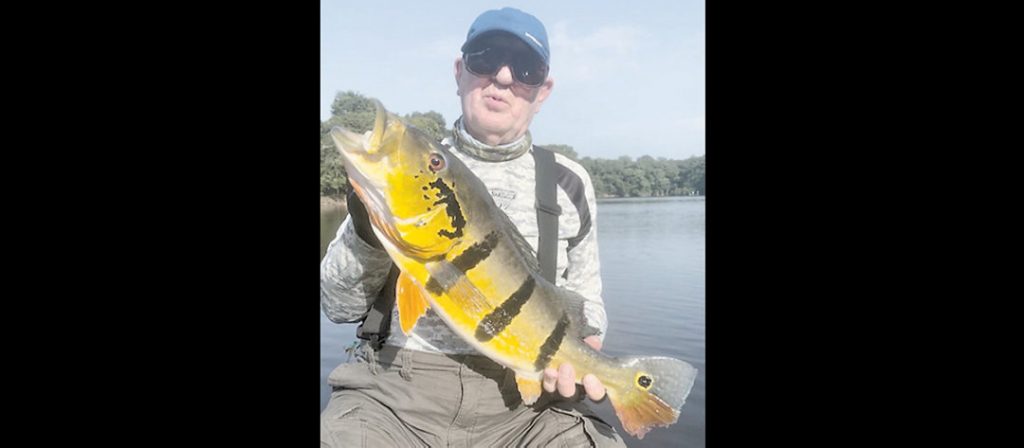During his first day on the river, Anthony Sulkevich thought he heard deer snorting.
He turned toward the sound and saw porpoises exhaling in a lagoon.
Sulkevich was a long way from his home in Freeland.
With a guide and a companion, he boated along the Branco River in Brazil. Their boat had a 40-horsepower motor and “would go like hell,” until the jungle hung so low along tributaries that Sulkevich ducked or disembarked to help push their 21-foot aluminum craft over sandbars.
Sulkevich, who plans to move to Oklahoma this month, has caught trout on the Delaware and Lehigh rivers, salmon in upstate New York and tuna off New Jersey, but he wanted to fish in Brazil for peacock bass.
“I knew about peacock fishing for a long time,” he said of big golden fish with orange fins, black horizontal stripes and an eye spot on the tail. “It’s on my bucket list.”
To chase peacock bass, Sulkevich left the airport in Avoca at 6 one morning in February and stepped onto a string of floating cabins along the Branco at 1 the following afternoon. His journey required a big jet, a nine-seater that landed on a dirt strip and a boat that took him about 30 miles up river.
Traveling alone during an increase in cases of COVID-19 that continued in Brazil after he left Feb. 20, Sulkevich had been vaccinated and submitted a negative test for the disease before boarding a plane. In Brazil, deaths from COVID-19 exceeded 500,000, more than in any nation except the United States.
“We never really mixed with the population,” Sulkevich said.
His guides were natives who lived along the river. At camp, he saw boat drivers, cooks, cleaners, mechanics and some of the employees’ children.
Asked if he thought tours like he took might provide dollars and jobs to preserve rainforest that is being burned for agriculture at an increasing pace, Sulkevich said he didn’t know how many people could afford to pay $10,000 for a week of fishing.
Another angler had enough disposable income to toy with chartering a seaplane for thousands of dollars to deliver fishing lures, an idea the man ultimately dropped.
Sulkevich, who retired after 33 years as a district manager for Pennsylvania’s Department of Public Welfare and volunteered as leader of Habitat for Humanity in Hazleton, previously saved his money for trips to reservoirs in the Mexican state of Sinaloa, where bass bulk up to 10 pounds.
But he liked being in Brazil so much that he booked another trip at a different locale in November. The floating cabins, he said, were spacious with a bathroom and shower, but he didn’t linger inside. He spent the afternoon of his arrival and the next six days on the boat after rising for breakfast at 5:30 a.m. Each day, he packed local sausages for lunch, rubbed on lotion with a sun protection factor of 50 and wore gloves to keep the backs of his hands from burning.
Temperatures reached 85 in the afternoons and dipped to 72 at night. He said the Branco, which feeds the Amazon River, is about five times the size of the Susquehanna River. Some channels narrowed enough that his guide packed a chainsaw to burr open a path.
Sulkevich admired birds wading on shore and the porpoises, which were pink and 5 feet long. Often, alligator-like caimans lingered within a football field of the boat. One afternoon, river police, looking for turtle smugglers, stopped the boat.
“Unsatisfied with the paperwork of the boat pilot, they made us go back 15 miles and delayed us three hours for them to get satisfied,” Sulkevich said.
The peacock bass, though, didn’t disappoint.
“For fishing, I’ve never had anything like it,” Sulkevich said.
Casting mostly in lagoons, he coaxed peacock bass to strike crankbaits and spinners that he would use for bass in Pennsylvania. The fish also hit jumping minnows and a noisy floating plug called a woodchopper.
On an email, he shared photos of 24 peacock bass and other species that he caught. The largest were 30 inches long and weighed at least 15 pounds. Most of the catch had pieces missing from their tails.
“Everything we hooked, piranha would attack,” Sulkevich said.
After releasing one fish, he watched a piranha bite the tail, and then a 10-foot caiman ate the rest.

Even after three decades as a reporter at the Standard-Speaker, Kent Jackson still enjoys meeting people, learning more about the community and sharing stories with readers. He currently covers schools but has reported on local government, health, police and the environment. Regularly, he writes about outdoor sports, wildlife and conservation for the Wildlife page on Sundays. Contact: 570-455-3636; kjackson@standardspeaker.com




